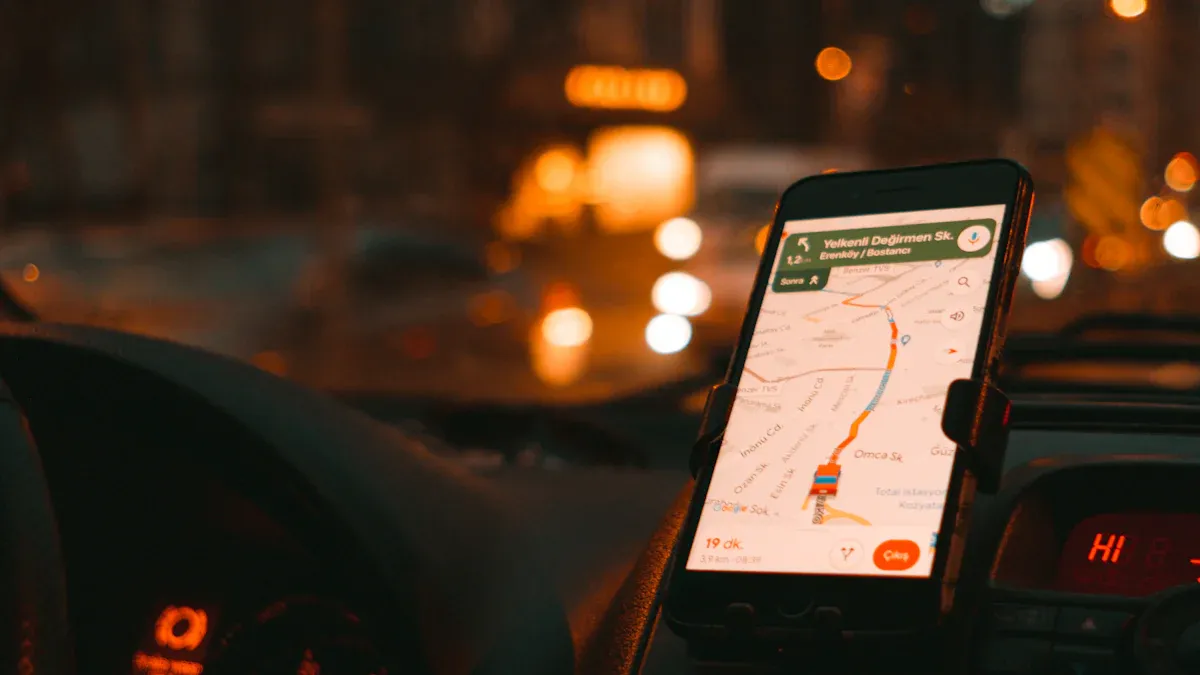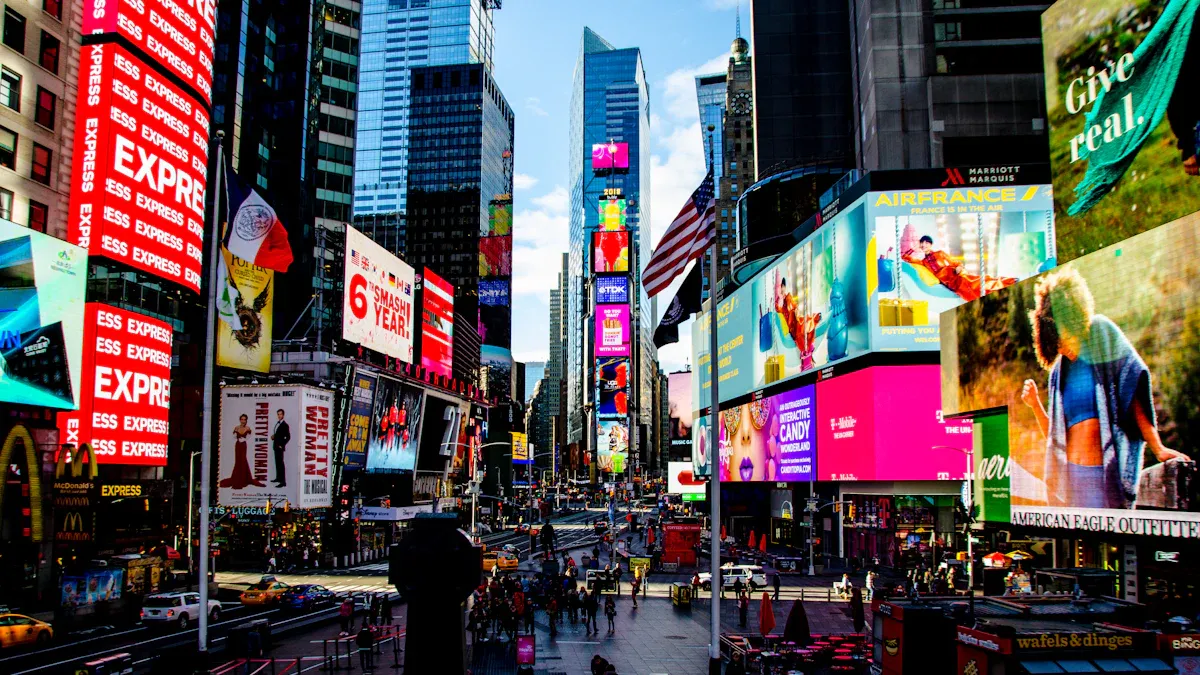
GPS-triggered taxi ads are changing how ads work. These ads use data to target people and send messages based on location. Advertising companies can now run campaigns that reach people at the best place and time. The market for in-taxi digital advertising, including GPS-triggered taxi ads, is growing fast.
Metric | Value |
|---|---|
Market Size in 2024 | 1.0 Billion USD |
Projected Market Size in 2032 | 3.0 Billion USD |
CAGR (2024-2032) | 15.00% |
This new idea lets companies connect with people right away. It also gives better data and helps find new clients.
Key Takeaways
GPS-triggered taxi ads use live location data. They show ads that fit where the taxi is. This makes ads more useful and works better.
This technology helps advertisers reach people at the best time. They can send messages made just for them. This helps get more attention and sales.
Dynamic pricing lets companies charge more for ads in busy spots. They can also charge more during big events. This helps them make more money.
Advertisers get lots of data and reports to see how ads do. They use this to make future ads better.
Privacy and rules are important. Companies must ask for permission and keep user data safe. This helps people trust them.
GPS-triggered taxi ads

Technology Overview
GPS-triggered taxi ads use smart technology to send ads to people. These systems have some main parts:
Internet of Vehicles (IoV) technology links taxis to networks and sensors. This lets taxis talk to control centers right away.
On-board smart devices, like iOS tablets, track where taxis are. They also send data wirelessly to help watch taxis all the time.
Communication devices such as IWCU use wireless signals like WAVE and DSRC. These let taxis talk to roadside units (RSUs) and other cars.
RSUs give Wi-Fi to passengers and special wireless links to drivers. This helps both riders and drivers stay connected.
A main control center runs the whole group of taxis. It watches taxis on a digital map and sends them out using live GPS data.
All these tools work together to add GPS-triggered taxi ads to taxis. The system helps with things like zone queuing and passenger hailing. It also lets ads change based on where the taxi is.
How They Work
GPS-triggered taxi ads work by using GPS and geo-fencing. When a taxi goes into a certain area, the ad changes to fit that place. A cloud-based content management system (CMS) controls these changes right away. The CMS can switch ads very accurately, even within five meters.
The system uses control cards with GPS to get location data and change ads.
Cloud platforms let people schedule and manage ads from far away.
Fleet managers can group taxis by route or time to show local ads.
The “play on arrival” feature shows ads when taxis reach busy or popular places.
Every ad shown is saved with GPS tags for tracking and making ads better.
This way, GPS-triggered taxi ads reach people at the best place and time. Advertisers can show food ads near restaurants or tourist info at famous spots. This makes ads more useful and easy to measure.
Unique Selling Points
Hyper-Targeting
Hyper-targeting is a big benefit of GPS-triggered taxi ads. This technology uses GPS and data about what people like. It helps show ads to the right person at the best time. AI systems make profiles for each rider and pick ads just for them. Geofencing makes invisible lines around places. When a taxi enters one, the system shows ads that fit that spot.
Studies say location-based messages work better than normal ones. Geofenced ads get three to five times more clicks. About 75% of people do something after getting a location-based message. Over half of shoppers go to a store after seeing these messages. These facts show hyper-targeting makes ads more useful and powerful. Brands can send messages that are timely and personal. This makes every ad count more.
Real-Time Engagement
Real-time engagement lets brands talk to people as they travel. Companies like Firefly use GPS ads on taxis in big cities. This helps track and change ads fast. Brands can switch ads right away based on where the taxi goes.
GPS-triggered taxi ads use location to show new messages.
Brands can reach certain areas and groups of people.
The system watches routes and links ads to people’s actions.
Real-time changes make ads show up at the best time.
Numbers like impressions and reach help check if ads work.
Marketers also look at website visits and social media likes.
Surveys and apps help get feedback from customers.
Analytics tools turn hard data into easy facts for marketers.
A/B testing and machine learning help pick the best routes.
This way, brands can make their ads better and reach more people.
Analytics and Measurement
Analytics and measurement tools help advertisers see how well ads do. GPS and location tracking show how many people see the ads. Bluetooth and beacons let ads talk to phones nearby. QR codes and NFC tags let people interact with ads and track results.
Audience tools mix traffic and phone data for deep insights.
Social media tools watch what people think and say.
Surveys check if people like the brand after seeing ads.
Big brands use these tools to get better results. Uber sends app messages to people near airports and hotels. Starbucks gives deals to people near stores to get more visits. Dunkin’ uses geofencing and Snapchat filters to reach more customers.
A table below shows how analytics help campaigns:
Aspect | Description |
|---|---|
Case Study 1 (City A) | Used GPS data from busy hours to plan prices and see supply and demand. |
Case Study 2 (City B) | Looked at rider spending and money using live GPS data to set prices. |
GPS and Ride Data Usage | Collected live data to guess demand and place drivers better. |
Surge Pricing Impact | Used math to balance cars and riders, helping drivers and making more money. |
Relevance to Taxi Ad Campaigns | The same ideas help with targeting and pricing in taxi ads. |
These tools help advertisers make smart choices and reach the right people. GPS-triggered taxi ads give more accuracy and better results. This sets a new standard for ads outside the home.
Revenue Opportunities

Dynamic Pricing
GPS-triggered taxi ads let companies use dynamic pricing. This means ad prices can go up in busy places or at big events. For example, a brand pays more to show ads near a stadium during a game. The system checks where the taxi is and changes the price. It looks at how many people are around and how much demand there is.
Tip: Dynamic pricing helps companies make more money by matching ad prices to what they are worth right now.
A simple table shows how prices can change:
Location Type | Example Event | Ad Rate (per hour) |
|---|---|---|
Downtown | Rush Hour | $50 |
Stadium District | Concert Night | $80 |
Airport | Holiday Travel | $70 |
Suburban Mall | Weekend Shopping | $40 |
New Client Segments
GPS-triggered taxi ads help companies find new clients. Local shops can reach people close to their stores. Event promoters can show ads to crowds at concerts or festivals. National brands can run ads in certain city areas.
Local restaurants can show lunch deals to taxis nearby.
Stores can tell shoppers about sales in busy malls.
Event organizers can sell tickets during big events.
Tourism boards can give info to visitors at landmarks.
These new groups help advertising companies grow their business.
Upselling Potential
Companies can use GPS-triggered taxi ads to sell extra services. They can offer better ad spots, live updates, or detailed reports. Clients might pay more for things like:
Custom ad times or places
Interactive ads with QR codes or NFC
Reports that show how many people saw or used the ad
This upselling brings in more money and helps clients get better results.
Effectiveness
ROI and Case Studies
GPS-triggered taxi ads help advertisers get better results. Companies like American Express use these ads to reach travelers near airports and hotels. Firefly is a top company in digital taxi ads. They have seen up to 30% more people interact with these ads than with regular taxi ads. Curb is another big company. They use live data to change ads and get more people to see them. Brands can count every time someone sees or clicks an ad. They learn which places and times work best. This helps them spend money where it matters most.
Note: Brands often get more value for their money because they can show ads to the right people at the right time.
A fast-food chain ran a campaign and saw 25% more people visit their stores when ads showed up near their locations at lunch. These results prove that GPS-triggered ads can help businesses grow.
Consumer Engagement
GPS-triggered taxi ads give people more chances to see and act on ads. Riders get messages that fit where they are and what they need. For example, a tourist in a taxi near a museum might see an ad for an exhibit close by. The system changes ads as the taxi moves. This keeps the ads new and useful.
Riders can use QR codes or NFC tags to interact with ads.
Brands can give special deals based on the taxi’s location.
Passengers remember these ads better because they feel personal.
These things help brands connect with people in ways that regular ads cannot.
Competitive Edge
GPS-triggered taxi ads are better than old taxi ads in many ways:
They use location services to change ads as taxis move.
Ads update right away when taxis enter new places.
Advertisers pick which ads show in each area and for how long.
GPS data links each ad to a place and time, so tracking is easy.
Digital screens in taxis help brands reach more people and make more money.
This technology gives advertising companies a big advantage. They can offer smarter and more flexible campaigns that get real results.
Implementation
Technical Needs
Advertising companies need good technology to run GPS-triggered taxi ads. The system uses both hardware and software. Important hardware includes GPS modules, 4G or 5G devices, screens inside taxis, and cameras for watching. Some systems use facial recognition and check if drivers are alert. These features help keep people safe and show better ads. The software tracks taxis in real time, plans routes, and saves data in the cloud. AI tools look at the data and pick the best ad for each moment. The system needs strong power and approved parts to work everywhere.
Component Category | Details and Features |
|---|---|
Hardware | GPS modules, 4G/5G, HD cameras, onboard displays, facial recognition, vital sign detection |
Software | Real-time tracking, video surveillance, route planning, cloud storage, backend management |
AI Features | AIoT integration, intelligent analysis, driver status detection, ADAS algorithms |
Communication & Data | 4G/5G connectivity, cloud upload, dual TF card storage |
Certifications | EU CE, ROHS, ISO 9001, ISO 14001 |
Companies work with cloud providers and control card makers. They also team up with city officials to manage ads and keep power steady. Programmatic ad partners help pick ads fast using location and who is nearby.
Privacy and Compliance
Privacy and following rules are very important for GPS-triggered taxi ads. Companies must ask before using location data. Many states say you need to tell people or get their okay for GPS tracking at work. Tracking should only happen when drivers are working to protect their privacy. Companies must follow laws like GDPR and only collect what they need. People should be able to say yes or no to sharing data. Companies use different tracking methods and check their systems to keep data safe. Telling people how their data is used helps build trust.
Tip: Always tell users about data collection and make privacy settings easy to use.
Best Practices
To make more money and run better campaigns, companies use smart ideas:
Hyper-contextual targeting means showing ads in the right place and time.
Weather targeting changes ads if it is sunny or rainy.
Geo conquesting gives deals to people near other businesses.
Beacon marketing uses Bluetooth for ads where signals are weak.
Big data analytics helps make ads personal and guess what people want.
Surge pricing raises ad prices when lots of people are around.
Strategic partnerships with local shops, hotels, and airports help reach more people.
Companies also set clear goals and watch how people react to ads. They give out coupons or rewards to get more people to join in and stay loyal.
GPS-triggered taxi ads help advertising companies find new ways to grow and make more money. There are many reasons why this is happening:
AI and Big Data help taxis work better and make ads smarter.
Real-time analytics let companies save money and use their tools well.
More people use ride-hailing apps, so there are more chances to show ads.
Smart transportation and electric taxis make the market more modern.
Agencies can use GPS-triggered taxi ads to reach more people and stay ahead of others. This is a good time to start using GPS-triggered taxi ads for a big advantage.
FAQ
What makes GPS-triggered taxi ads different from traditional taxi ads?
GPS-triggered taxi ads use live location data. They show ads that match where the taxi is right now. This helps brands talk to people in the best spot. Old taxi ads do not change with location.
How do companies protect user privacy with GPS-triggered taxi ads?
Companies follow privacy rules and laws. They ask riders before using their location data. They keep information safe with secure systems. Riders can say yes or no to sharing their data.
Are GPS-triggered taxi ads expensive to set up?
Starting costs are higher than regular ads. You need digital screens, GPS modules, and special software. But dynamic pricing and targeted ads can bring more money back to advertisers.
Can small businesses use GPS-triggered taxi ads?
Yes, small businesses can use this too. They can reach people close to their shops or events. Flexible prices and campaign choices help many business sizes use this technology.
What kind of data do advertisers get from these campaigns?
Advertisers get detailed reports from each campaign. These reports show how many people saw the ads and how they reacted. The data helps improve future ads and track how well they work.
See Also
Best CarPlay Devices Designed For VW Golf Drivers 2025
Budget-Friendly Portable CarPlay Solutions Suitable For All Drivers
Stay Updated With AI Box CarPlay Innovations In 2025
Cost-Effective Portable CarPlay Choices For BMW F10 Users
Leading Developments Influencing Wireless Android Auto Adapters
